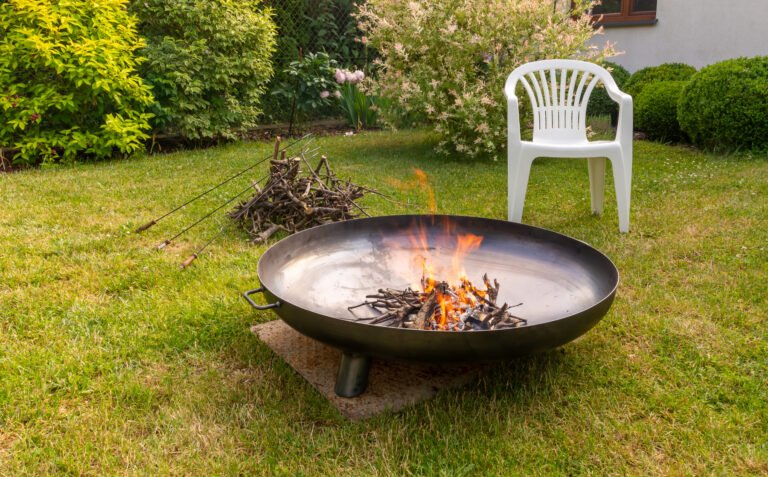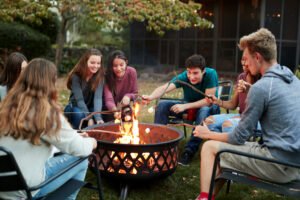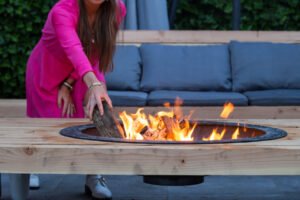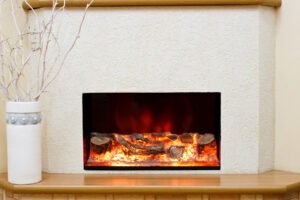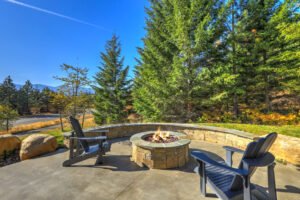A backyard fire pit provides a tremendous traditional campfire vibe. It is not just a warm source of light but also allows for a cozy night out! Not just that, you can even toast marshmallows or grill some chicken over it, and you have all you need for a party in your yard. Moreover, a portable fire pit is even better!
However, is a fire pit safe for your yard? Or is it a risk? And can you put a fire pit on the grass? There can be so many questions like these that might have come to your mind if you want to place an outdoor fire pit in your backyard. So let us look through this guide to find the answers.
Yes, you can put a fire pit on the grass using a fire pit mat or heat shield underneath it to protect the grass from excessive heat damage. Furthermore, avoid placing a fire pit directly on artificial turf as it may melt and ruin.
Is It Safe to Put a Fire Pit on Grass?
Yes, it is safe to put a fire pit on the grass. Moreover, as a fire pit is designed for the outdoors, there is no better location than your lawn. But because you are dealing with grass that can easily catch fire, you must be careful and follow all the needed precautions.
For instance, you should not put a fire pit near flammable facilities or trees and use specific barriers underneath for better protection. In addition, careful and responsible behavior is a must!
Can You Put a Fire Pit Directly on the Grass?
There are no hard and fast rules on whether you can put a fire pit directly on the grass or not. However, the answer is usually a no! Though there are no major safety concerns if you put it a proper distance away from flammable things, the main issue here is that the grass will be withered and turn an unpleasant brown color, ultimately damaging your entire lawn.
So it is well understood that there are some significant concerns if you put a fire pit directly on the grass. Let us see them in detail below!
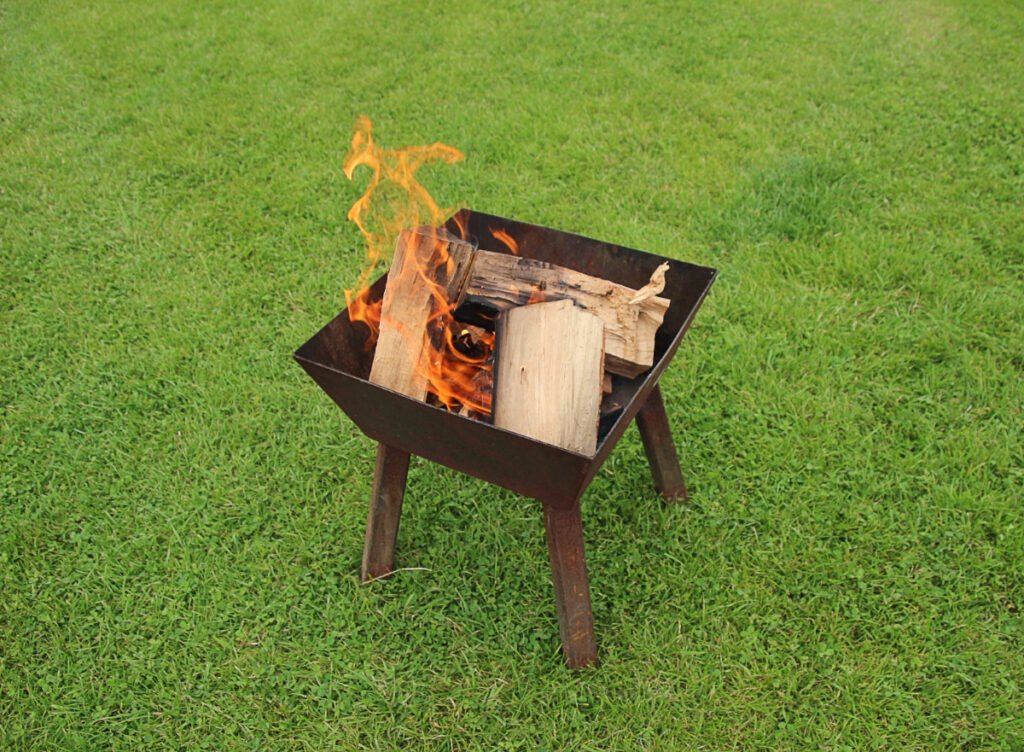
Heat Stress
Usually, in the summers, the grass on the lawn may experience some amount of heat stress. The high temperatures dry out the grass and weaken it to the point where it becomes difficult to grow. This can end up killing the overall lawn!
The exact process happens when the grass comes in direct contact with excessive radiant heat produced by a fire pit. And the heat stress caused here is much more than it is usually in the summers.
Another critical issue is that heat stress can also promote the production of weeds, making the lawn vulnerable to insects. Furthermore, due to all these reasons, you can become susceptible to diseases too!
Ghost Prints
Another critical point of concern of putting a fire pit on grass is ghost prints. What are ghost prints? You may ask. When something is left on the grass over a period of time, the pressure released from that specific thing can make it difficult for the grass to rise and grow.
This compression creates an unusual patch on the grass, and this patch is called a ghost print. So when a fire pit is placed directly on the grass, the pressure released from it can create a vast ghost print.
In addition, eventually, this can hamper the health of your grass and take a relatively long time for it to recover. Not just that, this unsightly patch can also look extremely unattractive and end up knocking down the aesthetics of your lawn.
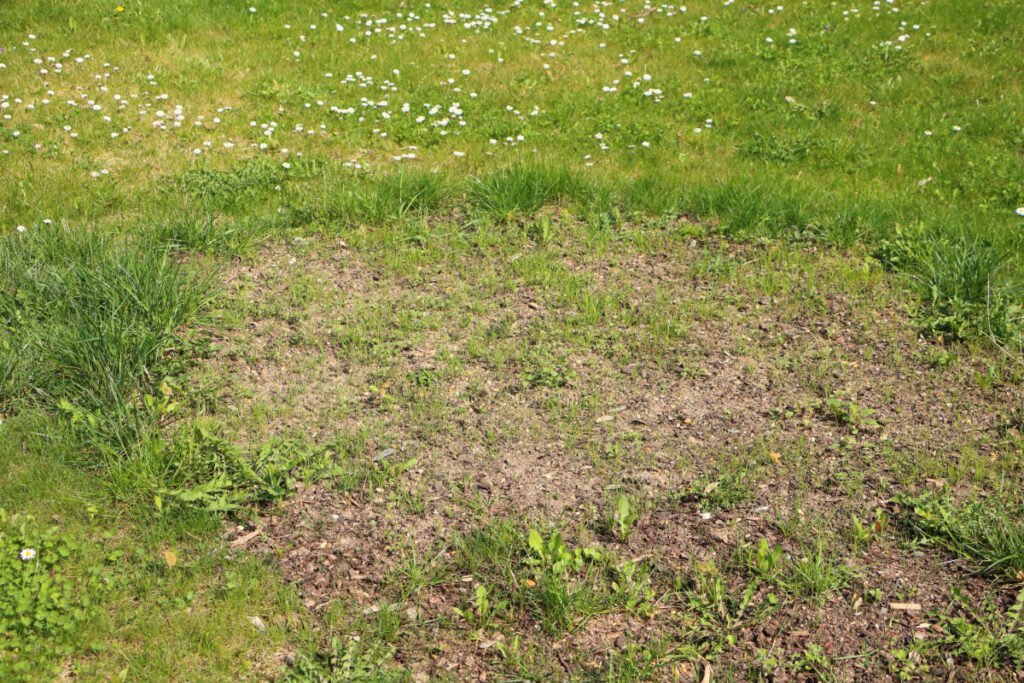
What Are Different Types of Fire Pits You Can Put on Grass?
There are different types of fire pits that can be placed on the grass with barriers underneath. For example, there are gas fire pits, stone fire pits, wood-burning fire pits, and steel fire pit options. Here are some prominent fire pit types you can put on grass.
1. Wood Burning Fire Pits: This wood fire pit uses wood to keep burning, which provides a cozy and natural vibe with its distinctive smell. You can use it as a portable choice or permanently install it.
2. Fire Pit Bowls: A fire bowl is a portable and low-maintenance fire pit. They can be found in different materials such as iron, steel, clay, and copper and can be easily put on grass. It is also the best option for cleaner surroundings!
3. Folding Fire Pit: These fire pits are designed for portable use such as camping or hiking. They are lightweight and generally made up of stainless steel. They are known as the popup fire pit too.
4. Fire Pit Table: This fire table looks like a table made of steel, coated with ceramic, porcelain, or stone to restrain heat damage on grass. Some fire pit tables have legs that make them portable, while some are permanent.
5. Propane Gas Fire Pit: These gas fire pits are the best option for winter. They are pre-installed in ceramic bowls and do not hamper the landscape. Also, a propane fire pit does not need wood nor give out any smoke.
6. Stone or Brick Fire Pit: These are the most common type of fire pit and are affordable too! You only need to buy bricks and stones from a store and put them together. It’s a traditional fire pit that’s extremely easy to build.
Other new and unique fire pit options include a wood fire pit, solo stove, barbeque grill fire pit, Weber kettle fire pit, and chiminea fire pit.
How to Protect Grass from Fire Pit Damage?
You can efficiently protect the grass on your lawn by following some crucial steps mentioned below:
- Put Something Underneath: The most effective and easiest way to protect your grass from fire pit damage is to place something as a barrier underneath the fire pit. This will reduce the possibility of fire damage and also provide a level surface.
- Find a Level Area: Find a level area to place a fire pit. If you put your fire pit on an uneven surface, you may be inviting a major safety hazard. The risk of the fire pit toppling and damaging the grass can be very high. This can injure a person near it and even spark a fire, which is highly undesirable.
- Choose a Big Barrier: Ensure that you have ample space and choose a big barrier that allows some distance between the support and the edge of the barrier to avoid the risk of the fire pit falling off. This will restrain damage to the grass and secure the safety of individuals.
- Wet the Grass: Another most accessible and cheapest way to combat heat stress and protect grass is to wet it before pacing a fire pit. Cover the lawn with enough water but ensure you are not waterlogging any area. This will work well as the water will evaporate when the fire pit begins to warm and will restrict any damage to the grass.
- Move the fire pit around: Lastly, keep on moving the fire pit around the yard and place it in safe locations. This will reduce compression, which can further hold back the grass’s damage.
What to Put under a Fire Pit on Grass?
You can put different things underneath your fire pit to stabilize it and reduce damage to the grass. But the common point is that the material should be heat and fire-resistant. Below are some of the best and most accessible materials you can put under your fire pit on grass.
Patio Slabs or Brick Pavers
The patio slabs or patio pavers are the most simple and cost-effective material to put underneath a fire pit. You can buy them in any local hardware shop and adjust them under your fire pit.
Also, you can quickly move these materials after using a fire pit to reduce compression and further damage to the grass. But if you don’t find concrete patio slabs, easily replace them with alternative brick pavers!
Heat Shield
A heat shield guards and acts as a defense against the heat produced from a fire pit. An additional benefit is that it can be placed on different surfaces – grass, concrete, wood floors, etc. You can easily place this heat shield under your fire pit for stress-free and safe use.
An easy, cheap, and efficient heat shield is an A-Team Performance Heat Shield, which can provide a barrier up to 2000 degrees. This heat shield can ultimately shield heat and reduce damage to the grass.
Fire-Resistant Mat
A fire-resistant mat or a fire pit mat is far easier to move and maneuver than bulky heat shields. In addition, these fire-resistant mats are much more prominent in size and exceptionally portable. They can be easily folded, which further helps in storage.
Another factor is most of them are waterproof and can be easily cleaned with a rinse and a quick wipe. You can easily hang them to line-dry or air-dry these mats. Also, a fire-resistant mat is durable and has good longevity as it can be reused many times.
Precautions to Take While Placing/Using a Fire Pit
If you insist on putting a fire pit on the grass, whether with something underneath or not, there are some highly crucial precautions you must take while placing and using a fire pit. Here are some of them.
Buy the Right Fire Pit
A good quality fire pit is worth the money compared to the cheaper ones. It is durable and long-lasting. In addition, the risk of fire pit toppling becomes exceedingly low, which solves safety concerns and restrains grass damage! So a right fire pit can fulfill all the concerns.
A Proper Placement
You must place the fire pit in the right location that allows enough distance from any nearby flammable structures and trees, or the risk of fire hazards will increase. Remember to maintain a 20-25 feet distance from facilities that can catch fire and at least 10-15 feet from tree branches.
Have a Good Preparation
The first step in preparing your lawn for a fire pit is removing and clearing dead grass, pine cones, and other combustible material. Next, ensure that the grass is not dried, as dry grass has a high propensity to catch fire.
Always ensure that the grass is raked after mowing the lawn, as leftover grass scraps can be present on the surface. Lastly, as a safety precaution, make sure to have a cleared area at least 10 feet from the fire pit.
Level the Area
The most important thing is to place a fire pit on a leveled area. However, if you do not have an even surface, you might as well level it. This is because an uneven surface can increase the chances of a fire pit falling off, which can turn out to be a dangerous accident.
But if you use a barrier underneath your fire pit, you must be even more careful. Sometimes, the fire pit, which looks stable when put directly on grass, can wobble on a barrier. So, double-checking is the key!
Avoid Adding Fuel
Adding lighter fuels can be an easier way to start a fire in a fire pit, but they should be avoided ultimately. These fuels can cause massive fires, spread out of the fire pit, and invite dangerous safety hazards.
Make Use of a Spark Screen
After the fire is put on well in a fire pit, place a spark screen over it to reduce sparks flying out from the fire pit. This will provide an additional safeguard to the grass underneath. Also, this will let you enjoy the flames!
Always Attend the Fire Pit
Adding lighter fuels can be an easier way to start a fire in a fire pit, but they should be avoided ultimately. These fuels can cause massive fires, spread out of the fire pit, and invite dangerous safety hazards.
Make Use of a Spark Screen
After the fire is put on well in a fire pit, place a spark screen over it to reduce sparks flying out from the fire pit. This will provide an additional safeguard to the grass underneath. Also, this will let you enjoy the flames!
Always Attend the Fire Pit
Never leave your fire pit unattended at any time. Even after using the fire pit, do not leave it out alone. But make sure to see that no ember is still there; if yes, put off the fire manually by splashing a bucket full of water.
Be Prepared in Every Case.
It is exceptionally vital to keep a bucket of water, a hose, or a fire extinguisher near you all the time for any emergencies because things can get unpredictable. So maintaining fire pit safety becomes the priority!
Can You Fix Grass Damaged by a Fire Pit?
Yes, you can fix grass damaged by a fire pit. However, if your grass is heavily damaged, you may need to reseed that area. In some cases, you can also replace the sod, but for a fresher feel, you can transplant new grass to the specific damaged location.
To fix the grass with minimal damage, you can just leave it alone for some time and water it regularly. And you will see the grass grow rich and healthier in a week or two!
And, if you have an artificial turf that has been damaged by the fire pit, you can just cut the damaged portion and replace it with a new patch.
How far should a fire pit be from a house?
You should maintain a distance of at least 10 – 25 feet from your house and your neighbor’s house. You should follow this safety protocol to avoid fire hazards and accidents.
Should I put sand in the bottom of my fire pit?
Yes, of course, you can put sand in the bottom of the fire pit. The main benefit is it will soak up heat and distribute it evenly throughout. In addition, lava rocks should be added to protect the metal bowl from exceptionally intense heat.
What kind of sand do you put in the bottom of a fire pit?
Silica sand is the most fireproof and affordable material you can put in the bottom of the fire pit. Next, top it up with fire pit glass and lava rock for a better effect.
A fire pit in your backyard is an excellent idea that gives a pleasant campfire vibe! However, placing a fire pit on grass might raise many questions. I hope this guide clears up all your doubts! If you’re still not sure, you can opt for effective firepit alternatives for your backyard instead of a conventional pit.

